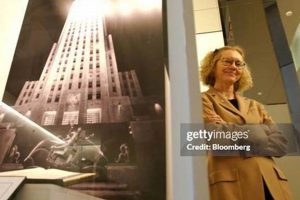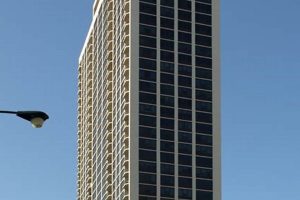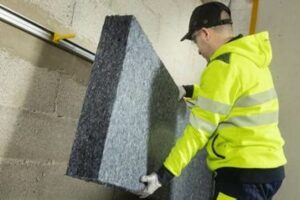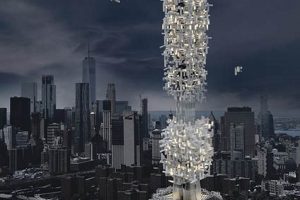Skyscrapers are high-rise buildings that are constructed using steel frames and reinforced concrete. They are typically over 150 meters (492 feet) tall and have multiple floors. Skyscrapers are often used for commercial purposes, such as offices, retail stores, and hotels.
Skyscrapers offer a number of benefits over traditional low-rise buildings. They are more space-efficient, as they can accommodate more people and businesses in a smaller area. They are also more energy-efficient, as they can be designed to minimize heat loss and gain. Additionally, skyscrapers can be more resistant to earthquakes and other natural disasters.
The first skyscraper was built in Chicago in 1885. Since then, skyscrapers have become a common sight in cities around the world. Some of the most famous skyscrapers include the Empire State Building in New York City, the Petronas Towers in Kuala Lumpur, and the Burj Khalifa in Dubai.
1. Height
The height of a skyscraper is one of its most defining characteristics. Skyscrapers are typically over 150 meters (492 feet) tall, and some of the tallest skyscrapers in the world are over 500 meters (1,640 feet) tall. This height gives skyscrapers a number of advantages over traditional low-rise buildings.
One of the main advantages of a skyscraper’s height is that it allows for more space-efficient use of land. Skyscrapers can accommodate more people and businesses in a smaller area than low-rise buildings, which is especially important in densely populated urban areas. Additionally, the height of a skyscraper can be used to create more energy-efficient designs. For example, skyscrapers can be designed to minimize heat loss and gain, which can reduce energy consumption.
The height of a skyscraper also has a number of practical advantages. For example, taller buildings can provide better views for occupants and can be used to create more iconic landmarks. Additionally, the height of a skyscraper can be used to create wind turbines and other renewable energy sources.
Overall, the height of a skyscraper is an important factor that contributes to its overall functionality and appeal. Skyscrapers are able to accommodate more people and businesses in a smaller area, are more energy-efficient, and can be used to create more iconic landmarks and generate renewable energy.
2. Structure
The structure of a skyscraper is one of its most important aspects, as it determines the building’s overall strength, stability, and durability. Skyscrapers are typically constructed using steel frames and reinforced concrete, which are two of the strongest and most durable building materials available.
Steel frames are used to create the skyscraper’s skeleton. The steel beams are welded together to form a rigid structure that can support the weight of the building and its occupants. Reinforced concrete is then used to fill in the spaces between the steel beams. The concrete is reinforced with steel rods, which gives it additional strength and durability.
The combination of steel frames and reinforced concrete creates a structure that is strong enough to withstand high winds, earthquakes, and other natural disasters. This makes skyscrapers one of the safest types of buildings in the world.
In addition to its strength and durability, the structure of a skyscraper also plays an important role in its energy efficiency. The steel frame and reinforced concrete help to insulate the building, which reduces heat loss and gain. This can lead to significant savings on energy costs.
Overall, the structure of a skyscraper is a critical component of its overall design. The use of steel frames and reinforced concrete creates a building that is strong, durable, and energy-efficient.
3. Function
Skyscrapers are not just tall buildings; they are also highly functional structures that serve a variety of purposes. The primary function of a skyscraper is to provide space for people to work, live, and shop. Skyscrapers can house offices, retail stores, hotels, and even residential units.
- Offices: Skyscrapers are a popular choice for businesses because they offer a number of advantages over traditional low-rise buildings. Skyscrapers can accommodate more employees in a smaller area, which can save businesses money on rent and utilities. Additionally, skyscrapers can be designed to be more energy-efficient than low-rise buildings, which can further reduce operating costs.
- Retail stores: Skyscrapers can also be a good location for retail stores, especially in densely populated urban areas. Skyscrapers can offer retailers more space to display their merchandise and can attract more customers due to their visibility and accessibility. Additionally, skyscrapers can be designed to include features that are attractive to shoppers, such as food courts, restaurants, and entertainment venues.
- Hotels: Skyscrapers are also a popular choice for hotels, especially in tourist destinations. Skyscrapers can offer hotel guests stunning views of the city and can be located near popular attractions and transportation hubs. Additionally, skyscrapers can be designed to include amenities that are attractive to travelers, such as swimming pools, fitness centers, and restaurants.
- Residential units: In recent years, there has been a growing trend towards building residential units in skyscrapers. Skyscrapers can offer residents a number of advantages over traditional low-rise buildings, such as stunning views, access to amenities, and proximity to transportation hubs. Additionally, skyscrapers can be designed to be more energy-efficient than low-rise buildings, which can save residents money on utilities.
The variety of functions that skyscrapers can serve makes them an essential part of the modern urban landscape. Skyscrapers provide space for people to work, live, and shop, and they can be designed to be energy-efficient and sustainable. As cities continue to grow, skyscrapers will likely become even more important in the future.
4. Efficiency
Skyscrapers offer a number of efficiency advantages over traditional low-rise buildings. These advantages include:
- Space efficiency: Skyscrapers can accommodate more people and businesses in a smaller area than low-rise buildings. This is because skyscrapers can be built vertically, which allows them to make use of more space. Additionally, skyscrapers can be designed with efficient floor plans that maximize the a
mount of usable space. - Energy efficiency: Skyscrapers can be designed to be more energy-efficient than low-rise buildings. This is because skyscrapers can be equipped with features such as double-glazed windows, energy-efficient lighting, and motion-activated sensors. Additionally, skyscrapers can be designed to take advantage of natural light and ventilation, which can further reduce energy consumption.
The efficiency advantages of skyscrapers make them an attractive option for businesses and individuals alike. Skyscrapers can help businesses save money on rent and utilities, and they can help individuals reduce their carbon footprint. Additionally, skyscrapers can help to create more sustainable and livable cities.
5. Safety
Skyscrapers are designed to be resistant to earthquakes and other natural disasters. This is an important consideration, as skyscrapers are often built in areas that are prone to seismic activity or other natural hazards. There are a number of design features that can be used to make skyscrapers more resistant to these forces, including:
- Structural design: Skyscrapers are typically built with a steel frame that is designed to withstand high winds and earthquakes. The frame is made of strong steel beams that are welded together to form a rigid structure. The frame is then filled in with concrete, which adds strength and mass to the building.
- Foundation: Skyscrapers are built on deep foundations that are designed to anchor the building to the ground. The foundation is typically made of concrete and steel, and it is designed to spread the weight of the building over a large area. This helps to prevent the building from sinking or toppling over in the event of an earthquake.
- Dampers: Skyscrapers can be equipped with dampers, which are devices that help to reduce the amount of movement that the building experiences during an earthquake. Dampers can be made of a variety of materials, including steel, concrete, and fluid. They work by absorbing energy from the earthquake and dissipating it through friction or other means.
These are just a few of the design features that can be used to make skyscrapers more resistant to earthquakes and other natural disasters. By incorporating these features into their designs, engineers can help to ensure that skyscrapers are safe for occupants and the surrounding community.
6. Sustainability
Sustainability is an increasingly important consideration in the design and construction of skyscrapers. Green roofs and solar panels are two features that can help to make skyscrapers more sustainable. Green roofs are roofs that are partially or completely covered with vegetation. They provide a number of benefits, including reducing energy costs, improving air quality, and providing habitat for wildlife. Solar panels are devices that convert sunlight into electricity. They can be used to generate renewable energy for the building, which can help to reduce the building’s carbon footprint.
There are a number of real-life examples of skyscrapers that have been designed to be sustainable. One example is the Burj Khalifa in Dubai, which is the tallest building in the world. The Burj Khalifa has a number of sustainable features, including a double-skin facade that helps to reduce energy consumption, and a rainwater harvesting system that collects and reuses rainwater. Another example is the One World Trade Center in New York City, which is the tallest building in the United States. The One World Trade Center has a number of sustainable features, including a green roof and a solar panel array that generates renewable energy for the building.
The practical significance of understanding the connection between sustainability and skyscrapers is that it can help us to design and construct buildings that are more environmentally friendly and sustainable. Green roofs and solar panels are two features that can help to reduce the environmental impact of skyscrapers. By incorporating these features into the design of skyscrapers, we can help to create a more sustainable future.
7. Iconicity
Skyscrapers are often seen as symbols of power and prosperity. This is because they are typically built in large cities, which are often centers of commerce and finance. Skyscrapers can also be seen as symbols of technological achievement, as they require a high level of engineering and construction expertise to build. In addition, skyscrapers can be seen as symbols of national pride, as they are often the tallest buildings in a country.
There are many real-life examples of skyscrapers that have become iconic symbols of their cities. The Empire State Building in New York City, the Petronas Towers in Kuala Lumpur, and the Burj Khalifa in Dubai are just a few examples. These buildings are not only popular tourist destinations but also symbols of the economic and cultural power of their respective cities.
The practical significance of understanding the connection between iconicity and skyscrapers is that it can help us to appreciate the role that skyscrapers play in shaping our cities and our world. Skyscrapers are not just tall buildings; they are also symbols of power, prosperity, and achievement. By understanding this, we can better appreciate the importance of skyscrapers and the role that they play in our lives.
Skyscraper FAQs
This section addresses frequently asked questions about skyscrapers, providing informative responses based on credible sources.
Question 1: What is the tallest skyscraper in the world?
Answer: The Burj Khalifa in Dubai, standing at 828 meters (2,717 feet) tall.
Question 2: What is the function of skyscrapers?
Answer: Skyscrapers serve diverse functions, including housing offices, retail stores, hotels, and residential units.
Question 3: Are skyscrapers safe in the event of natural disasters?
Answer: Skyscrapers are designed with safety features such as reinforced concrete structures, deep foundations, and dampers to withstand earthquakes and other natural disasters.
Question 4: How do skyscrapers contribute to sustainability?
Answer: Sustainable skyscrapers incorporate green roofs, solar panels, and rainwater harvesting systems to reduce their environmental impact.
Question 5: What is the cultural significance of skyscrapers?
Answer: Skyscrapers are often iconic symbols representing a city’s power, prosperity, and technological advancement.
Question 6: How do skyscrapers impact urban planning?
Answer: Skyscrapers influence urban planning by optimizing land use, promoting vertical development, and creating mixed-use spaces within cities.
In summary, skyscrapers serve critical functional, safety, sustainability, cultural, and urban planning roles in modern society.
Moving on to the next section, we will delve into the architectural and engineering marvels of sk
yscrapers.
Skyscraper Tips
Skyscrapers are architectural marvels that define skylines and push the boundaries of engineering. Here are valuable tips to gain insights into these towering structures:
Tip 1: Understand Structural Systems
Skyscrapers employ various structural systems, including braced frames, moment frames, and core-braced systems. Each system provides stability and strength to withstand lateral forces like wind and earthquakes.
Tip 2: Optimize Vertical Transportation
Efficient vertical transportation is crucial in skyscrapers. Elevators, escalators, and sometimes skybridges connect different floors, ensuring smooth movement of occupants and reducing wait times.
Tip 3: Integrate Sustainable Features
Sustainable skyscrapers incorporate eco-friendly elements like green roofs, solar panels, and rainwater harvesting systems. These features reduce energy consumption and promote environmental responsibility.
Tip 4: Consider Mixed-Use Design
Mixed-use skyscrapers combine different functions, such as offices, residential units, and retail spaces. This approach maximizes land utilization and creates vibrant urban environments.
Tip 5: Ensure Fire Safety
Skyscrapers prioritize fire safety through compartmentalization, fire-resistant materials, and advanced fire suppression systems. These measures minimize the spread of fire and protect occupants.
Tip 6: Enhance Energy Efficiency
Energy-efficient skyscrapers employ double-glazed windows, LED lighting, and automated building controls. These measures reduce energy consumption and operating costs.
Tip 7: Plan for Future Adaptability
Skyscrapers should be adaptable to changing needs and technologies. Flexible floor plans, modular construction, and adaptability to future uses ensure the longevity and relevance of these structures.
Summary:
Understanding these tips provides valuable insights into the design, engineering, and functionality of skyscrapers. By embracing innovation, sustainability, and safety, we can continue to create awe-inspiring and functional skyscrapers that shape our cities and skylines.
Conclusion
Skyscrapers have transformed urban landscapes and redefined the possibilities of architecture and engineering. Their height, efficiency, and iconic status make them symbols of progress and innovation.
As we continue to push the boundaries of design and sustainability, skyscrapers will undoubtedly evolve to meet the changing needs of our cities and societies. They will continue to serve as testaments to human ingenuity and our for vertical living.







